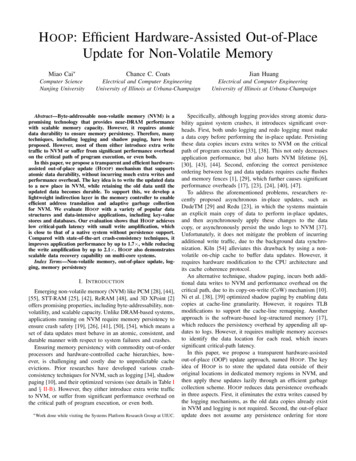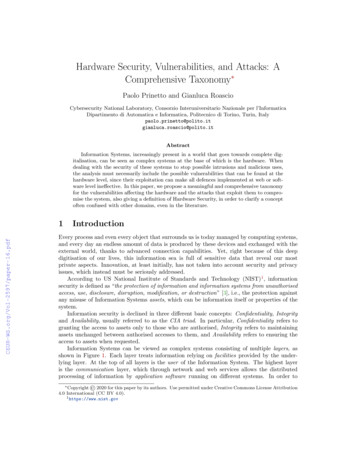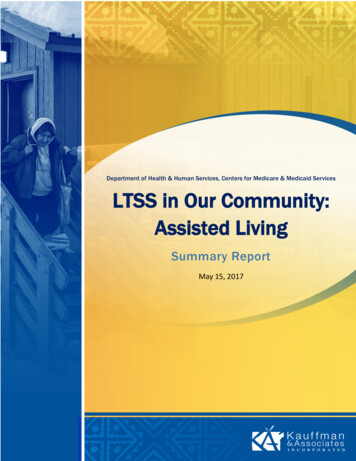
Transcription
H OOP: Efficient Hardware-Assisted Out-of-PlaceUpdate for Non-Volatile MemoryMiao Cai Chance C. CoatsJian HuangComputer ScienceNanjing UniversityElectrical and Computer EngineeringUniversity of Illinois at Urbana-ChampaignElectrical and Computer EngineeringUniversity of Illinois at Urbana-ChampaignAbstract—Byte-addressable non-volatile memory (NVM) is apromising technology that provides near-DRAM performancewith scalable memory capacity. However, it requires atomicdata durability to ensure memory persistency. Therefore, manytechniques, including logging and shadow paging, have beenproposed. However, most of them either introduce extra writetraffic to NVM or suffer from significant performance overheadon the critical path of program execution, or even both.In this paper, we propose a transparent and efficient hardwareassisted out-of-place update (H OOP) mechanism that supportsatomic data durability, without incurring much extra writes andperformance overhead. The key idea is to write the updated datato a new place in NVM, while retaining the old data until theupdated data becomes durable. To support this, we develop alightweight indirection layer in the memory controller to enableefficient address translation and adaptive garbage collectionfor NVM. We evaluate H OOP with a variety of popular datastructures and data-intensive applications, including key-valuestores and databases. Our evaluation shows that H OOP achieveslow critical-path latency with small write amplification, whichis close to that of a native system without persistence support.Compared with state-of-the-art crash-consistency techniques, itimproves application performance by up to 1.7 , while reducingthe write amplification by up to 2.1 . H OOP also demonstratesscalable data recovery capability on multi-core systems.Index Terms—Non-volatile memory, out-of-place update, logging, memory persistencyI. I NTRODUCTIONEmerging non-volatile memory (NVM) like PCM [28], [44],[55], STT-RAM [25], [42], ReRAM [48], and 3D XPoint [2]offers promising properties, including byte-addressability, nonvolatility, and scalable capacity. Unlike DRAM-based systems,applications running on NVM require memory persistency toensure crash safety [19], [26], [41], [50], [54], which means aset of data updates must behave in an atomic, consistent, anddurable manner with respect to system failures and crashes.Ensuring memory persistency with commodity out-of-orderprocessors and hardware-controlled cache hierarchies, however, is challenging and costly due to unpredictable cacheevictions. Prior researches have developed various crashconsistency techniques for NVM, such as logging [34], shadowpaging [10], and their optimized versions (see details in Table Iand § II-B). However, they either introduce extra write trafficto NVM, or suffer from significant performance overhead onthe critical path of program execution, or even both. Workdone while visiting the Systems Platform Research Group at UIUC.Specifically, although logging provides strong atomic durability against system crashes, it introduces significant overheads. First, both undo logging and redo logging must makea data copy before performing the in-place update. Persistingthese data copies incurs extra writes to NVM on the criticalpath of program execution [33], [38]. This not only decreasesapplication performance, but also hurts NVM lifetime [6],[30], [43], [44]. Second, enforcing the correct persistenceordering between log and data updates requires cache flushesand memory fences [1], [29], which further causes significantperformance overheads [17], [23], [24], [40], [47].To address the aforementioned problems, researchers recently proposed asynchronous in-place updates, such asDudeTM [29] and Redu [23], in which the systems maintainan explicit main copy of data to perform in-place updates,and then asynchronously apply these changes to the datacopy, or asynchronously persist the undo logs to NVM [37].Unfortunately, it does not mitigate the problem of incurringadditional write traffic, due to the background data synchronization. Kiln [54] alleviates this drawback by using a nonvolatile on-chip cache to buffer data updates. However, itrequires hardware modification to the CPU architecture andits cache coherence protocol.An alternative technique, shadow paging, incurs both additional data writes to NVM and performance overhead on thecritical path, due to its copy-on-write (CoW) mechanism [10].Ni et al. [38], [39] optimized shadow paging by enabling datacopies at cache-line granularity. However, it requires TLBmodifications to support the cache-line remapping. Anotherapproach is the software-based log-structured memory [17],which reduces the persistency overhead by appending all updates to logs. However, it requires multiple memory accessesto identify the data location for each read, which incurssignificant critical-path latency.In this paper, we propose a transparent hardware-assistedout-of-place (OOP) update approach, named H OOP. The keyidea of H OOP is to store the updated data outside of theiroriginal locations in dedicated memory regions in NVM, andthen apply these updates lazily through an efficient garbagecollection scheme. H OOP reduces data persistence overheadsin three aspects. First, it eliminates the extra writes caused bythe logging mechanisms, as the old data copies already existin NVM and logging is not required. Second, the out-of-placeupdate does not assume any persistence ordering for store
TABLE I: Comparison of various crash-consistency techniques for NVM. Compared with existing works, H OOP provides atransparent hardware solution that significantly reduces the write traffic to NVM, while achieving low persistence gLog-structured NVMUndo RedoPageCache lineH OOPRepresentative ProjectDCT [27]ATOM [24]Proteus [47]PiCL [37]Mnemosyne [49]LOC [32]BPPM [31]SoftWrAP [14]WrAP [13]DudeTM [29]ReDU [23]FWB [40]BPFS [10]SSP [39]LSNVMM [17]Read LowLowHighLowoperations, which allows them to execute in a conventionalout-of-order manner. Third, persisting the new updates in newlocations does not affect the old data version, which inherentlysupports the atomic data durability.Since the update is written to a new place in NVM,we develop a lightweight indirection layer in the memorycontroller to handle the physical address remapping. H OOPenables high-performance and low-cost out-of-place updatewith four major components. First, we organize the dedicatedmemory regions for storing data updates in a log-structuremanner, and apply data packing to the out-of-place updates.This makes H OOP best utilize the memory bandwidth of NVMas well as reduce the write traffic to NVM. Second, to reducethe memory space cost caused by the out-of-place updates,H OOP develops an efficient garbage collection (GC) algorithmto adaptively restore the out-of-place updates back to theirhome locations. To further reduce the data movement overheadduring GC, we exploit a data coalescing scheme that combinesthe updates to the same cache lines. Therefore, H OOP onlyneed to restore multiple data updates once, which furtherreduces the additional write traffic. Third, H OOP maintainsa hash-based address-mapping table in H OOP for physical-tophysical address translation, and ensures that load operationsalways read the updated data from NVM with trivial addresstranslation overhead. Since the entries in the address-mappingtable will be cleaned when the corresponding out-of-placeupdates are periodically written back to their home addresses,the mapping table size is small. Fourth, H OOP enables fastdata recovery by leveraging the thread parallelism available inmulti-core computing systems.As H OOP is developed in the memory controller, it is transparent to upper-level systems software. No non-volatile cacheor TLB modifications for address translation are required.Unlike software-based logging approaches that suffer fromlong critical-path latency for read operations, H OOP providesan efficient hardware solution with low performance overheadand write traffic, as shown in Table I. Overall, we make thefollowing contributions in this paper: We present a hardware out-of-place update scheme to ensurethe crash-consistency for NVM, which alleviates extra writetraffic and avoids critical-path latency overhead in NVM.On the Critical quire Flush & FenceNoNoNoNoYesNoYesYesNoNoNoNoYesYesNoNoWrite ighMediumHighHighLowMediumLow We propose a lightweight persistence indirection layer inthe memory controller with minimal hardware cost, whichmakes out-of-place updates transparent to software systems. We present an efficient and adaptive GC scheme, which willapply the recent data updates from the out-of-place updatememory regions to their original locations for memory spacesaving and write traffic reduction.We implement H OOP in a Pin-based many-core simulator,McSimA [5], with the combination of an NVM simulator. Weevaluate H OOP against four representative and well-optimizedcrash-consistency approaches, including undo logging [24],redo logging [13], optimized shadow paging [38], and logstructured NVM [17]. We use a set of microbenchmarksrunning against these popular data structures like hashmaps,B-trees [23], [24], [40], [47], and real-world data-intensiveapplication workloads like Yahoo Cloud Service Benchmark(YCSB) and transactional databases [36]. Experimental resultsdemonstrate that H OOP significantly outperforms state-of-theart approaches by up to 1.7 in terms of transaction throughput, and reduces the write traffic to NVM by up to 2.1 ,while ensuring the same atomic durability as existing crashconsistency techniques. H OOP also scales the data recovery aswe increase the number of threads on a multi-core system.We organize the rest of the paper as follows. We discussthe background and motivation in § II. We describe the designand implementation of H OOP in § III. We evaluate H OOP in§ IV, present its related work in § V, and conclude it in § VI.II. BACKGROUND AND M OTIVATIONA. Atomic Durability for NVMNVM requires atomic durability to ensure crash consistency.Atomicity refers to a group of data updates happening in anall-or-nothing manner in case the program crashes, while durability requires these data updates are eventually persisted in thepersistent storage. In modern memory hierarchies that consistof volatile CPU caches and persistent memory, unpredictablecache-line evictions make it challenging to achieve atomicdurability, because they could cause only a subset of modifieddata to become durable before the system experiences anunexpected crash or application failure [8], [52], [54].
Log WriteCPUCachesData CopyCPUMemory ControllerMemory ControllerMemory ControllerOut-of-place WriteCPUCachesCachesCachesMemory ControllerLog WriteCPUdata coalescingOld DataLogsNVM(a) LoggingOld DataCopyNVM(b) Shadow PagingIndexLogsNVM(c) Log-structured NVMOld Datadata packingNew DataNVM(d) H OOPFig. 1: Illustration of different crash-consistency techniques. (a) Logging technique requires that both logs and data mustbe persisted, which incurs double writes; (b) Shadow paging maintains two copies of data, it suffers from copy-on-writeoverhead; (c) Log-structured NVM alleviates the double writes, but it suffers from significant overhead of index lookup; (d)Our hardware-assisted out-of-place update reduces the write amplification significantly, while providing efficient data accesses.Enforcing atomic durability on current computer architectures is non-trivial. Commodity hardware provides instructionsfor atomic data update, but this hardware-supported atomicityonly supports small granularities (8 bytes for 64-bit CPUs).To ensure these atomic updates become durable, applicationsmust flush cache lines to persist data to NVM. For a group ofdata updates having a larger size, they have to rely on othercrash-consistency techniques, such as write-ahead loggingand shadow paging, to achieve atomic durability. Althoughthese crash-consistency mechanisms support strong atomicdurability, applying them to NVM is costly. We will discusstheir details in the following section § II-B.B. Crash-consistency TechniquesWe categorize the crash-consistency techniques for NVMinto three major types: logging [34], shadow paging [10],and log-structured NVM [17]. We summarize their recentrepresentative work in Table I.Logging on NVM: Write ahead logging (WAL) is widelyused for NVM. Its core idea is to preserve a copy beforeapplying the change to the original data (see Figure 1a). Thelogging operations result in doubled write traffic and worsenthe wear issue with NVM [17], [38]. To reduce the loggingoverhead, hardware-assisted logging schemes such as bulkpersistence [23], [24], [31], [40] have been proposed. However,they can only partially mitigate the extra write traffic (seeFigure 8 in our evaluation).Beyond increasing the write traffic, logging also incurslengthy critical-path latency [29], [41]. This issue is especiallyserious for undo logging, since it requires a strict persistordering between log entries and data writes. Redo loggingprovides more flexibility, as it allows asynchronous log truncation and data checkpointing [13], [14], [23], [31], [49], whichcontributes to a shorter critical-path latency. However, it stillgenerates doubled write traffic eventually.Decoupling logging from data updates with asynchronousin-place update is another approach, as proposed in SoftWrAP [14] and DudeTM [29]. It decouples the executionof durable transactions and logging, therefore, the number ofmemory barrier operations can be reduced. However, it needsto track the updated data versions, and the software-basedaddress translation inevitably introduces additional overhead tothe critical-path latency. And this approach still cannot reducethe write traffic to NVM.Despite each of these logging approaches applying variousoptimizations, logging is still expensive, due to a simplereason: they are restricted by their intrinsic extra log writefor each update, regardless of whether the update takes placesynchronously or asynchronously.Shadow Paging: Shadow paging can eliminate expensivecache flushes and memory fence instructions, however its writeamplification is still a severe issue. With shadow paging, anentire page has to be copied, even though only a small portionof data is modified (see Figure 1b). Recent work proposeda fine-grained copy-on-write technique [38], [39] to reducethe write amplification. In this approach, one virtual cacheline is mapped to two physical cache lines, and it ensuresdata atomicity at cache-line granularity. However, it requiresfrequent TLB updates to track the committed cached linesin NVM, which would sacrifice the performance benefitsobtained from the cache-line copy-on-write optimization.Log-structured NVM: Inspired by log-structured file systems [46], Hu et al. [17] proposed a software-based logstructured NVM, called LSNVMM, in which all the writesare appended into a log. Such an approach alleviates thedouble writes caused by the undo/redo logging. However, itincurs significant software overhead for read operations dueto the complicated data indexing (see Figure 1c) and garbagecollection. Although the index can be cached in DRAM, it stillrequires multiple memory accesses to obtain the data location.For instance, LSNVMM requires O(log N ) memory accessesfor each data read, due to the address lookup in an indextree, where N is the number of log entries. This significantlyincreases the read latency of NVM.C. Why Hardware-Assisted Out-of-Place UpdateAs discussed, the proposed crash-consistency approaches,such as logging, shadow paging, and log-structured memory,either increase the write amplification of NVM, or cause longcritical-path data access latency, or even both.
In this paper, we propose a new approach: hardware-assistedout-of-place update, in which the memory controller writes thenew data to a different memory location in a log-structuredmanner, and asynchronously applies the data update to itshome address periodically. It alleviates the extra write trafficcaused by the logging, and avoids the data copying on thecritical path as discussed in shadow paging. Our proposedapproach maintains a small physical-to-physical address mapping table in the memory controller for address translation, andadaptively writes the data updates into their home addresses.Therefore, it incurs minimal indirection and GC overhead. Wefurther leverage data packing and coalescing to reduce thewrite traffic to NVM during the GC.Our proposed hardware out-of-place update ensures theatomic data durability by default, as it always maintains theold data version in NVM, while persisting the updates in newmemory locations in a log-structured manner. It also doesnot assume any persistence ordering for store operations as itis implemented in the memory controller, which significantlyreduces the performance overhead caused by memory barriers.III. D ESIGN AND I MPLEMENTATIONA. Design Goals and ChallengesTo perform hardware-assisted out-of-place updates efficiently, we aim to achieve the following three goals: (1)we will guarantee crash-consistency, while minimizing criticalpath latency and write traffic to NVM; (2) we aim to maketrivial hardware modifications, thus minimizing the cost of oursolution, while simplifying the upper-level software programming; (3) we will develop a scalable and fast data recoveryscheme by exploiting the multi-core computing resources.To achieve hardware-assisted out-of-place update, a straightforward approach is to persist updated cache lines alongwith necessary metadata to NVM in an out-of-place manner.However, we have to overcome the following challenges.First, persisting the data and metadata eagerly at a cacheline granularity will introduce extra write traffic as well asnegatively affect system performance. Second, the indexing forout-of-place updates could introduce additional performanceoverhead to data accesses. Third, the required GC operationsfor free space will introduce additional write traffic to NVM aswell as performance overhead. Inspired by the flash translationlayer for flash-based solid-state drives [4], [15], [18], wepropose an optimized and lightweight indirection layer in thememory controller to address these aforementioned challenges.B. System OverviewTo support memory persistency, transactional mechanismshave been developed as the standard approach because oftheir programming simplicity [23], [24], [29], [45], [49], [54].Instead of inventing a new programming interface for NVM,H OOP provides two transaction-like interfaces (i.e., Tx beginand Tx end) to programs, and enables programmers to handlethe concurrency control of transactions for flexibility, as proposed in these prior studies. These interfaces demarcate thebeginning and end of a transaction which requires data atomicout-of-place updateCache HierarchyLoadMemoryControllerStoreMapping Table §3.3OOP Data Buffer §3.3Eviction Buffer §3.3Data Packing§ 3.3Home RegionOOP Region §3.4NVMGarbage Collection § 3.5Fig. 2: Hardware-assisted out-of-place update with H OOP.H OOP performs out-of-place writes and reduces write trafficwith data packing and coalescing. To reduce the storageoverhead, H OOP adaptively migrates data in the out-of-place(OOP) region back to the home region with optimized GC.durability. H OOP only needs programmers to specify a failureatomic region using Tx begin and Tx end, without requiringthem to manually wrapping all read and write operations, andadding clwb and mfence instructions.We present the architectural overview of H OOP in Figure 2.During transaction execution, data is brought into the cachehierarchy with load and store operations. They will accessthe indirection layer to find the most recent version of thedesired cache line (see §III-C). For the updated cache lines in atransaction, they are buffered in the OOP data buffer in H OOP.Each entry of this buffer can hold multiple data updates aswell as the associated metadata. And persistence optimizationssuch as data packing are applied to improve the transactionperformance, when flushing the updated cache lines to theOOP region (see §III-D). With the out-of-place writes, H OOPis crash-safe by ensuring committed transactions are persistedin the OOP region before any changes are made to the originaladdresses (i.e., the home region). As OOP region will be filledwith updated data and metadata, H OOP performs periodic GCto migrate the most recent data versions to the home region,and uses data coalescing to minimize the write traffic to NVM(see §III-E). Upon power failures or system crashes, H OOPwill leverage thread parallelism to scan the OOP region andinstantly recover the data to a consistent state (see §III-F).C. Indirection Layer in the Memory ControllerTo provide crash-safety, H OOP must ensure that all updatesfrom a transaction have been written to NVM before any ofthe modified cache lines in the transaction could be evictedand written to the home region. To guarantee this ordering,H OOP writes cache lines which are modified by transactionsinto the OOP region instead of the home region.OOP Data Buffer. To improve the performance of out-ofplace updates, H OOP reserves an OOP data buffer in the memory controller (see Figure 2). Each core has a dedicated OOPbuffer entry (1KB per core) to avoid access contention duringconcurrent transaction execution. It stores the updated cachelines and associated metadata (i.e., home-region address),and facilitates the data packing for further traffic reduction.Specifically, H OOP tracks data updates at a word granularity
N cache linesM1AM2BM3C.M8EA0Memory SliceData packingA B C . EM1 M2 . M8A1 store A12 cache linesFig. 3: Data packing in H OOP.A1A0 undo logB0B1Tx beginA1.D0FlushA1 redo logD1E0E1TimeF0F1G0 G1Tx endTime(a) Undo loggingB1 . D1E1F1G1A0 B0 . D0 E0F0Tx begin(b) Redo logginginstead of a cache line granularity during data persistence,motivated by the prior studies showing that many applicationworkloads update data at a fine granularity [9], [53]. H OOPapplies data packing to reduce the write traffic during out-ofplace updates. As shown in Figure 3, data residing in severalindependent cache lines are compacted into one single cacheline. Similarly, H OOP also performs metadata packing forfurther traffic reduction. We show that metadata which areassociated with eight data updates are also packed into a singlecache line in Figure 3.H OOP packs up to eight pieces of data and their metadatainto a single unit, named a memory slice (see the detailsin § III-D). As for multiple updates in the same cache linehappened in a transaction, H OOP will pack them in the samememory slice. We use a 40-bit address offset preserved in themetadata to address the home region (1TB). As NVM couldhave a larger capacity, the metadata size will also increase.To overcome this challenge, H OOP needs to only reduce thenumber of cache lines being packed (N in Figure 3). For ahome region whose size is 1 PB (250 ), H OOP can pack sevenunits of cache lines (56 bytes) and their metadata in a memoryslice, which still occupies two cache lines.Persistence Ordering: H OOP flushes the updated data andmetadata to the OOP region in two scenarios. First, if theH OOP has packed eight cache lines in the OOP data bufferduring transaction execution, it will flush the packed memoryslice into the OOP region. Second, if the transaction executesthe Tx end instruction, H OOP will automatically flush theremaining data along their metadata to the OOP region.H OOP maintains the persistence ordering in the memorycontroller, which does not require programmers to explicitlyexecute cache-line flushes and memory barriers. We depictthe transaction execution of different approaches in Figure 4.Undo logging requires strict ordering for each data update,incurring a substantial number of persistence operations duringtransaction execution. Redo logging mitigates this issue andonly requires two flush operations per transaction: one for theredo logs and another for the data updates. Both schemes haveto perform extra writes to NVM. The optimized shadow pagingscheme can avoid additional data copy overheads. However, asshadow paging can only guarantee data atomicity. To ensuredata persistence, it has to eagerly flush the updated cache lines,causing severe persistency overhead. H OOP uses the OOP databuffer to store the data updated by a transaction, and flushesthe data in the unit of memory slice. Upon Tx end instruction,H OOP persists the last memory slice to the OOP region.Address Mapping. To track these cache lines for futureaccesses, H OOP uses a small hash table maintained in theA1B1.D1E1F1Tx beginTx endTimeG1Tx end(c) Shadow pagingA1 B1 . D1 E1Tx beginG0TimeF1 G1Tx end(d) Hardware-assisted out-of-place updateFig. 4: Transaction execution of different approaches. Bothundo and redo logging deliver lengthy transaction executiontimes due to log writes. Shadow paging has to copy additionaldata before performing in-place updates. H OOP achieves fasttransaction execution with out-of-place updates.memory controller to map from home region addresses to theOOP region addresses (physical-to-physical address mapping).Compared to the software-based approaches, H OOP performsthe address translation transparently in hardware and avoidsexpensive software overheads and TLB shootdown [17], [38].Whenever a cache line is evicted from the LLC within atransaction, the cache line is written into the OOP region.H OOP adds an entry to the mapping table for tracking itslocation. In the mapping table, each entry contains its homeregion address as well as the OOP-region address.H OOP removes entries in the mapping table under twoconditions. First, the most recent data versions have beenmigrated from the OOP region to the home region during theGC (see details in §III-E). Second, upon an LLC miss, H OOPwill check the mapping table to determine whether the cacheline should be read from the home region or OOP region. If itsaddress is present in the table, it will be read from the OOPregion. H OOP will remove this entry, since the most recentversion is located within the cache hierarchy, and the existingcache coherence mechanisms will ensure this data will be readby any other requesting cores.The mapping table in H OOP is essentially used to trackthe cache lines in the OOP region. It is shared by all cores.Its size is a function of the maximum number of evicted andflushed cache lines between two consecutive GC operations inNVM. In this paper, we use 256 KB per core as the size of themapping table (2 MB in total) by default. And our evaluation(see §IV) shows this size provides reasonable performanceguarantee for data-intensive applications.Eviction Buffer. Along with the mapping table, H OOP hasan eviction buffer to store cache lines (and their home-regionaddresses) that were written back to NVM during GC. Bybuffering the evicted cache lines, H OOP ensures that when amapping table entry is being removed during the GC, a newmapping to the most recent version of the corresponding cache
OOP RegionHead OOP Block1Addr Addr.Head OOP Block1AddrAddr Addr AddrPrev Slice Next SlicePrev Slice Next SliceDataDataDataDataDataNext SliceAddr AddrBlock IndexTablePrev Slice Next SliceTx:0AddrHead OOP Block1Tx:1DataDataDataTx:0Next SliceDataNext SliceOOP Block(a) OOP region organizationMemory SliceData 0Data 1.Data 7MetadataHome Addrs TxID Start Cnt Flag Next Slice320 bit32 bit1 bit3 bit 4 bitPad24 bit(b) Data memory slice layoutFig. 5: Layout of the OOP region. H OOP organizes the OOPregion in a log-structured manner. Each OOP block consistsof memory slices with a fixed size. There are two types ofmemory slices: data memory slice and address memory slice.line is still maintained. Therefore, the misses in the LLC willnot read stale data. Upon an LLC miss, if the address of themissed cache line is not present in the mapping table, H OOPwill first check the eviction buffer. If the missed cache line isnot in the eviction buffer, H OOP will read the data from thehome region. As H OOP migrates data from the OOP regionto the home region at a small granularity during the GC, therequired eviction buffer size is small (128 KB by default).D. OOP Region OrganizationH OOP organizes the OOP region in a log-structured mannerto minimize fragmentation and enable sequential writes forhigh throughput. The OOP region is consisted of multiple OOPblocks (2MB per block). The OOP region has a block indextable (direct mapping table) to store the index number andstart address of each OOP block. This block index table willbe cached in memory controller for fast data lookup.OOP Block: We present the layout of an OOP block inFigure 5a. Each OOP block has an OOP header storing theblock metadata. The header consists of (1) an 8-bit OOP blockindex number; (2) a 34-bit address pointing to the next OOPblock; (3) a 2-bit flag denoting the block state (BLK FULL,BLK GC, BLK UNUSED, BLK INUSE). The remainder ofan OOP block is composed of memory slices with a fixedsize of 128-bytes. The fixed-size memory slices place anupper bound on the worst-case fragmentation which can occurwithin an OOP block, and H OOP can easily manage OOPblocks with a memory slice bitmap. Further, the 128-byte sizeof a memory slice means that H OOP is capable of flushingthe memory slices to the OOP region using two consecutivememory bursts [22].Memory Slice: We classify memory slices into two categories: data memory slices and address memory slices. Asshown in Figure 5a, a large transaction can be composed ofAlgorithm 1 Garbage Collection in H OOP.1: Definitions: Home region: M emhome ; OOP region: M emoop ; OOP block:Blkoop ; Memory slice bitmap: Bitmap; Mapping Table: M T ;2:3: fo
memory regions for storing data updates in a log-structure manner, and apply data packing to the out-of-place updates. This makes HOOP best utilize the memory bandwidth of NVM as well as reduce the write traffic to NVM. Second, to reduce the memory space cost caused by the out-of-place updates, HOOP develops an efficient garbage collection .










